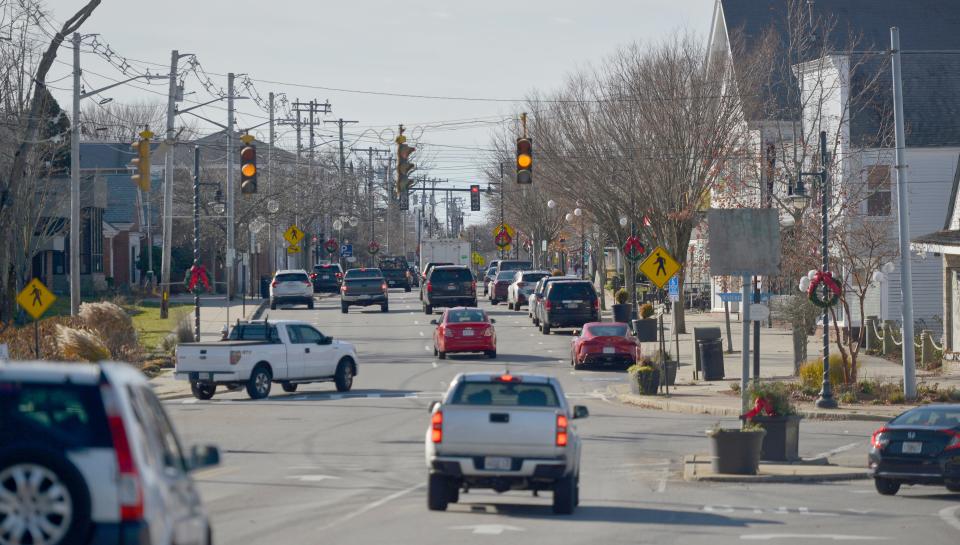No more plastic awnings: Why business owners could face new rules on buildings downtown
BARNSTABLE — Forewarned is forearmed.
And the Planning and Development Department in Barnstable is trying to make owners and developers aware of just what could be considered appropriate for any exterior renovations and construction where the Growth Incentive Zone overlaps with the Hyannis Main Street Waterfront Historic District. The area covers a swath from North to South streets and reaches down Old Colony Road and Ocean Street to the waterfront. It runs generally along Main Street from School to Stevens streets
The 53-page Downtown Hyannis Unified Design Guidelines and Regulations document gives developers, designers, town boards and officials a clear roadmap of what applies when it comes to exterior improvements. The document covers everything from windows and doors to signs, landscaping and parking to the use of historic colors. The document is now online and available for public comment through Sept. 15.

This document will eventually replace the design standards currently in place and create consistent standards for both the Growth Incentive Zone and the Hyannis Main Street Waterfront Historic District, according to proponents.
Why is it necessary?
The Planning Board and the Hyannis Main Street Historic District Commission have worked on the guidelines that “champion the historic and maritime character of downtown Hyannis,” according to the document.
Rob Brennan, a former developer and now an attorney with Smolak & Vaughan, said writing guidelines is a difficult task because they have to apply to all potential properties and allowed buildings. He said they strike a balance between giving good directions so private developers can work up project plans that don't require a back and forth when plans go before the Historic District Commission or Planning Board. The guidelines also give investors a sense of certainty about how the neighborhood will be developed.
More: What can make downtown Hyannis great? This city planner has big ideas.
"It lends to a more efficient process," Brennan said. "Good architects can read well-written guidelines and come in pretty close to mark first time around. It's comforting (to know) that adjacent properties, if redeveloped, will be redeveloped to those same standards as spelled out in guidelines."
The downtown area includes two National Register Historic Districts, a Municipal Group National Register Historic District and the Pleasant Street/School Street National Register Historic District. Between the two districts are six historic municipal buildings, 12 properties listed on the National Register of Historic Places and another 14 properties eligible for listing.
Protecting and preserving the historical character of buildings and locations in downtown Hyannis was the impetus for establishing the Hyannis Main Street Waterfront Historic District Commission. With the guidelines in place, no building permit for construction or alteration of exterior architectural features will be issued until a certificate of appropriateness, certificate of non-applicability or certificate of hardship is issued by the commission.
What’s allowed, encouraged, prohibited and discouraged:
Allowed: A palette of historic colors, including those published by the group Historic New England. Maximum of three colors on the storefront façade. Cedar shakes and clapboards. Balconies facing public rights of way and bay windows are encouraged.
More: 'Bunch of paint' and traffic barriers: Big and small upgrades to downtown Hyannis laid out
Prohibited: Vinyl, metal or plastic awnings or canopies. Flashing, blinking, scrolling, or video signs or displays. Trees planted on steep embankments. Highly reflective metallic building materials. False building fronts are discouraged, as are storefront windows and doors outlined in aluminum. Flat roofs except for the Main Street storefront area are also discouraged.
Repercussions:
Should an applicant not receive a certificate of appropriateness, they can revise the application and reapply to the commission, or appeal the decision. An appeal committee will make the final determination. The enforcement of all zoning and regulations in Barnstable falls to the building department and special services division, according to Senior Planner James Kupfer.
Brennan said Barnstable has a long history of revitalization led by the town and the Hyannis Main Street Business Improvement District.
"All of those pieces have been put in place over many years and I think we’re starting to see the fruits of that labor attracting national developers," he said.
When the public comment period ends, planning and development department staff will provide recommendations to the Planning Board and Historic District Commission. Adoption of guidelines by both bodies would make them effective. The guidelines will not be retroactive, Kupfer said.
To review the draft proposal go to https://www.townofbarnstable.us/departments/planninganddevelopment/. Public comments will be accepted through Sept. 15 and can be submitted to James Kupfer at James.Kupfer@town.barnstable.ma.us or to the Planning and Development office, 367 Main Street, Hyannis, MA 02601.
Denise Coffey writes about business and tourism. Contact her at dcoffey@capecodonline.com.
Thanks to our subscribers, who help make this coverage possible. If you are not a subscriber, please consider supporting quality local journalism with a Cape Cod Times subscription. Here are our subscription plans.
This article originally appeared on Cape Cod Times: Design rules could benefit Hyannis developers, residents, tourists

